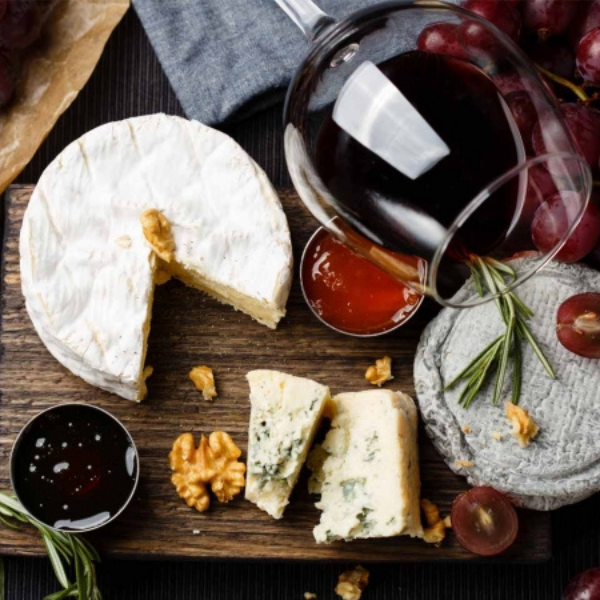WINE AND CHEESE, A SENSORY EXPERIENCE!

Wine and cheese are two products offering great gastronomic joys either in a daily level or finding the perfect match which can give a greater gastronomic experience.
As in every pairing with food and wine, we can find different views, if we want to consume as best possible correspondence of those, we have to consider as many information about them, without becoming obsessive.
Either we choose a wine to accompany a cheese platter, or pick some cheese to enjoy a wine, the goal, -if it comes to a targeted pairing- is the same: to avoid creating an unpleasant feeling with the taste of the wine. For a successful pairing, choosing cheese doesn’t reduce the pleasure of the wine. In some cases, not very often, a cheese can amplify the essence of the wine. On the other side, rarely we need to think how a wine can affect a cheese. Mainly cheese is the dominant partner in this pairing.
As products, they share many common elements. They are both fermentation products, they age and mature, they have aromas and flavors due to their raw material, fermentation and maturation. The processes they go through give them special characteristics, which have potential to evolve. Also they share the need for a careful preservation.
Having in mind the characteristic they share; we can also admit that they create a natural pairing! For sure, many pairings can be made based on personal preferences, but many misinterpretations can occur regarding their pairing. For example, they form an ideal pairing without any criteria, or some kind of cheese create a nice pairing with red wine, something with which mane professionals disagree. It is common and reasonable when proteins of the cheese combine in the mouth with tannins of a red wine to reduce the astringent feeling and the bitter taste. But in reality, the overall result is completely different, without disregarding the fact that some exceptional pairings can happen. Every cheese due to its unique structure, which grants it with a special taste and aromas.
They are divided in some categories, which are:
• Fresh soft cheeses with no maturation process like Mizithra, Ricotta, Mozzarella. Soft cheeses, with no compression and low-fat content, which are a fermentation product, as mentioned.

• Semi-hard, with 36-40% moisture like Cheddar or some with more aromatically intense like Reblochon
• Hard, with 25-36% with taste in some cases sweetens because of the protein breakdown into amino acids, over their long maturation process, such as the Gouda cheese in which the moisture is removed by compression and the gruyere where along with compression, we also have reheating.
• Very hard cheese, like Parmigiano-Reggiano, with moisture level below 25%.
• Blue cheese, where various fungi give a more intense and spicier flavor like Gorgonzola
• Washed Rind cheese, a bath in brine, beer or wine etc. produces a unique orange crust with special characteristics, like Chaume, Livarot or Munster.
• Bloomy, a white mold on the outer part, like Camambert or Robiola. They tend to be more reach and creamier, with a soft texture. Their “skin” is edible and affects the flavor, because the “skin” flavor is more intense from the inside part. So, we can understand that due to the different styles of production and the characteristics the develop, we have to take an approach the combination calculating the differences. The easiest solution is a cheese platter, cut like finger food to accompany the wine, but usually if we are dealing with a more specific situation, is not the ideal solution.
After all, cheese is a food, historically are historically consumed at any time of the day and are not a complete / special meal by themselves, by gastronomy keeps evolving! For a better result, we consider the facts listed below, when we have to decide.
Texture. Is the cream creamy and does it cover the palate or is it tight and dry? Is the wine crispy and refreshing like a New Zealand Sauvignon Blanc for example, or a full bodied, velvety Viognier from Rhone Valley. Matching the texture of a cheese and a wine is a good strategy. Another option could be the contrast created by choosing a cream cheese, combined with a sparkling wine to “cleanse” the palate.
Intensity. For delicate wines, we choose delicate cheese. For robust wines, we use cheese with more condense flavor and aromas. In case of fresh, like goat cheese, we are more fresh wine orientation. Likewise, for mature cheeses, like Parmigiano-Reggiano, with increased intensity, the ideal pairing is a wine with intense and full flavor.

Acidity. Acidity, when it comes to a cheese and wine pairing, is a crucial factor. An cheese with high acidity, like Cheddar or a Valençay, a wine with solid acidity as well is a good idea.
Sweetness. A cheese can’t be literally sweet. With the exception of very fresh cheeses, such as Cottage cheese, which may not have yet been lactose fermented, the cheeses do not have measurable sugars. Nevertheless, we perceive in some cheeses a sweetness or a feeling of candy at the end. For example, a Boerenkaas (photo) and a Lincolnshire Poacher leave this impression. With these cheeses a “dry fruit” Palo Cortados Sherry or a Madeira Malmsey can be very enjoyable.
Mold. A blue cheese can seem flawless next to an intense red wine, but this can be proved a catastrophic pairing. Instead, a dessert wine faces the strength of blue cheese and prevents a collision of taste with the mold. So, we have an important exception. The veins of the “mold” in the blue cheeses strip the dry white and red wines of their fruity characteristics. A sweet wine is almost always the best choice. The spicier and saltier “blue”, the richer the dessert wine should be. Surprisingly, sparkling wines can keep their character combined with many blue cheeses!
Locality. Combining a cheese with a wine from the same area can many times prove satisfying, mainly on an emotional level. Indeed, in some cases is successful, but we do not rely on this guideline indiscriminately. Many cheeses come from areas, where wine is not produced. Some wines seem like a great challenge for cheese lovers. Wines with a intense barrel hints, especially in the case of whites, are difficult to combine with cheeses. Tannic reds also need special attention.
They work best with dry, aged cheeses, such as Parmigiano-Reggiano or aged Manchego or Pecorino Toscano, but the combination is rarely perfectly satisfactory. Closing a faster and more daily approach without “tiring” our minds with a lot of information could be some “rules” such as:
• Light white wines with light cheeses, such as goat or sheep milk cheeses with a Chenin Blanc.
• White high-acid wines with high-acid cheeses, such as an aged chèvre with a Sauvignon Blanc from a cool climate.
• Wines with less emphasis on acidity with low acidity cheeses, such as a Gouda with a strongly “barrel” Chardonnay from California.
• Strong wines with strong cheeses, such as aged Cheddar with a Syrah or red wines from Rhone.
• Dessert wines with strong, savory cheeses, such as blue cheeses with Sauternes or

